Central Arandor
Central Arandor is dominated by the Ashara Desert, an immense and arid expanse within Dhuma, flanked by the Zandari Mountains and the fertile basins of Eouma and Jou’lunn. Its landscape is defined by vast shifting sand dunes, rocky canyons, and isolated oases, creating an environment both breathtaking and perilous. The desert’s stark beauty belies its dangers, where scorching heat, sudden sandstorms, and treacherous terrain test the endurance of those who traverse it.
The Canyons of Varka, with their labyrinthine pathways and sheer cliffs, are particularly infamous. These canyons serve as natural fortresses, hiding ancient ruins, lost cities, and whispers of treasure buried beneath the sands. However, their twisting paths and sudden drops make them perilous to navigate, earning them a reputation as the “Graveyard of Travelers.”
Rising above the desert, the Zandari Mountains form the backbone of Central Arandor, acting as both a barrier and a lifeline. Their towering peaks influence the region’s weather patterns, blocking rain clouds and casting the desert into perpetual aridity. At the same time, they harbor hidden springs and lush valleys, providing vital refuge and resources to the nomadic tribes and caravans that depend on them.
This region’s unforgiving conditions have fostered cultures of resilience, resourcefulness, and survival. The people of Central Arandor are shaped by the desert’s demands, blending tradition and adaptability to thrive in an environment where nature is both adversary and ally.
Geography
Central Arandor’s geography is shaped by the vast Ashara Desert, which dominates much of the region with its shifting dunes, rocky plateaus, and arid basins. This unforgiving expanse is flanked by the Zandari Mountains, whose jagged peaks form a natural barrier between the desert and the fertile lands of Eouma and Jou’lunn.
The Canyons of Varka, carved by ancient rivers, stretch across the southern reaches of the desert, creating a maze of narrow gorges and towering rock spires. These canyons are both awe-inspiring and treacherous, hiding caves, natural springs, and rumored ruins from forgotten civilizations.
Sparse oases are scattered throughout the Ashara Desert, fed by underground aquifers and rare rainfall. These pockets of life support palm groves and hardy shrubs, serving as vital waypoints for travelers and nomadic tribes.
To the north, the desert transitions into rocky foothills and grasslands, offering slightly more hospitable terrain. Rivers fed by snowmelt from the Zandari Mountains carve through this area, creating fertile valleys that sustain settlements and trade routes connecting Dhuma to its neighbors.
The Zandari Mountains themselves are rugged and imposing, with snow-capped peaks in the highest elevations and hidden passes that lead to secluded valleys. Rich in metals and precious stones, these mountains are both a source of wealth and danger, attracting miners and outlaws alike.
Along the eastern edge, the coastal cliffs give way to rocky shores and salt flats, where the desert meets the sea. These areas are subject to strong winds and tidal surges, but they also offer rich fishing grounds and access to maritime trade routes.
The geography of Central Arandor reflects the tension between survival and beauty, where towering mountains, deep canyons, and rolling dunes create a landscape as dangerous as it is mesmerizing.
Ecosystem
The ecosystem of Central Arandor reflects its harsh, arid conditions and the resilience required to survive within the Ashara Desert and the towering Zandari Mountains. It is a landscape of extremes, where life has adapted to scorching heat, limited water, and rugged terrain, creating a delicate but enduring balance.
Desert Ecosystem
The Ashara Desert is dominated by hardy plant life, such as cacti, succulents, and thorny shrubs, which store water in their thick stems and roots. Scattered acacia trees and date palms grow near oases, their deep root systems tapping underground aquifers. Grasses and flowering plants bloom briefly after rare rains, transforming patches of the desert into bursts of color before fading back into dormancy. Animal life in the desert is highly adapted to heat and scarcity. Sand vipers and scorpions thrive in rocky crevices, while fennec foxes and jerboas burrow underground to escape the heat. Gazelles and wild goats roam the dunes and rocky outcrops, feeding on sparse vegetation, while hawks and eagles circle overhead, hunting smaller prey. Nomadic herders rely on camels, which are perfectly adapted to long journeys through the arid landscape. Larger predators, such as sandshadow panthers and jackals, hunt during cooler nights, blending into the dunes to ambush prey. Legends also speak of sand wyrms—giant serpentine creatures that burrow beneath the sands and emerge during storms, adding an element of danger and myth to the desert’s reputation.Mountain Ecosystem
The Zandari Mountains create a stark contrast, offering shelter and resources not found in the open desert. The lower slopes are dotted with juniper, pine, and scrub bushes, while higher elevations support hardy alpine grasses and lichen-covered rocks. Glacial meltwater forms streams that carve through valleys, sustaining plant and animal life along their banks. Mountain-dwelling animals include ibex and mountain goats, which navigate rocky cliffs with ease, while snow leopards stalk them from above. Eagles and vultures ride thermal currents, scanning the slopes for carrion. Smaller creatures, like marmots and hares, make their homes in crevices and burrows, serving as prey for the region’s predators.Oasis Ecosystem
The scattered oases throughout the desert act as vital hubs of life, supporting rich biodiversity compared to the surrounding sands. Palm groves, reed beds, and flowering plants create shelter and sustenance for insects, birds, and amphibians. Frogs, fish, and waterfowl thrive in these rare water sources, attracting predators such as serpents and wild cats. Nomadic tribes and caravans also rely heavily on these oases, cultivating date palms, fig trees, and medicinal herbs, making these areas not just lifelines for survival but centers of trade and cultural exchange.Mythical Life
Stories of the Sand Striders, massive insect-like creatures that leave intricate patterns in the dunes, and storm elementals said to rise during sandstorms, are woven into local folklore. Some believe the Canyons of Varka harbor stone guardians—living statues protecting ancient ruins—or hidden lairs of fire drakes, creatures drawn to the heat and minerals of the mountains.Ecological Challenges
The fragile ecosystems of Central Arandor are highly susceptible to disruption. Overgrazing, mining, and unsustainable water usage threaten the delicate balance of life. Sandstorms and droughts further test the resilience of both flora and fauna, ensuring that survival depends on constant adaptation to the region’s harsh realities. Despite its challenges, Central Arandor’s ecosystem is a testament to nature’s ability to thrive under adversity, creating a world of beauty, danger, and mystery.Ecosystem Cycles
Central Arandor’s ecosystem cycles reflect its extreme climate and arid conditions, shaped by seasonal changes and the scarcity of water. These cycles dictate the behavior and survival strategies of its flora and fauna, creating rhythms of growth, migration, and dormancy.
Dry Season (Late Spring through Summer)
The dry season dominates much of the year, with scorching heat and little to no rainfall. The Ashara Desert bakes under an unrelenting sun, and the sands become scorching during the day, cooling drastically at night. Plants enter a dormant phase, conserving water within thick stems, roots, or leaves. Many shrubs and succulents shed leaves or curl inward to reduce moisture loss, while cacti bloom briefly to attract pollinators before retreating into survival mode. The oases shrink, forcing animals and nomads to cluster around the few remaining water sources. Animals adapt by becoming nocturnal or crepuscular, active only during cooler parts of the day. Predators, like sand wolves and desert lions, shift their hunting patterns to dawn and dusk, stalking prey near waterholes. Rodents and insects burrow into the sand to escape the heat, and reptiles absorb warmth from rocks to remain active during the cold desert nights. The Zandari Mountains, while cooler, experience limited rainfall, forcing animals to descend toward valleys where glacial streams still flow. Grazing animals like ibex and mountain goats rely on sparse alpine grasses, while snow leopards track them through rocky crevices.Rainy Season (Late Autumn through Early Winter)
Rain is rare but transformative when it comes. Sudden rainstorms sweep through the desert, flooding dry riverbeds and filling seasonal lakes. These flash floods bring a sudden burst of life, replenishing underground aquifers and sustaining oases. Plants bloom rapidly after the rain, creating temporary meadows of wildflowers and grasses. These brief periods of abundance attract migratory birds and grazing animals that take advantage of the sudden food supply before it vanishes. Insects hatch in swarms, feeding birds and amphibians, and frogs emerge to breed in the shallow pools. Predators become more active, taking advantage of prey gathering at water sources. Nomadic tribes move to take advantage of the oases’ renewed resources, holding trade fairs and celebrations before dispersing again. In the Zandari Mountains, melting snow from higher elevations replenishes streams, providing sustenance for forests and wildlife along the foothills.Cool Season (Late Winter through Early Spring)
The cool season marks a temporary reprieve from the heat, with cooler days and cold nights that allow plants and animals to recover. While rainfall remains scarce, lingering moisture from earlier storms sustains deep-rooted plants and grasses in valleys. Animals migrate toward warmer areas, with some desert herds moving closer to the mountains to graze in sheltered valleys. Mountain predators, such as eagles and wolves, follow these migrations, preying on weakened animals during the journey. Reptiles and insects retreat to hibernation or burrows, while larger mammals grow thicker coats or rely on fat reserves built up during wetter months. Camels and other livestock used by nomads adapt to the cooler temperatures, making longer journeys across the desert feasible.Water and Migration Cycles
Water is the lifeblood of Central Arandor, and its cyclical availability shapes nearly every ecological process. Animals and people alike follow the water cycle, moving between oases, glacial streams, and temporary lakes as they appear and disappear. Nomadic tribes and caravan routes mirror these movements, ensuring survival through careful planning and cooperation. Bird migrations align with these cycles, bringing flocks of waterfowl and raptors to the desert after storms, while coastal areas see increases in marine life during wetter periods.Mythical Cycles
Legends tie sandstorms to supernatural cycles, claiming that storms stir when ancient spirits rise or sand wyrms awaken beneath the dunes. Local traditions often hold rituals during these storms to appease the spirits or ward off danger. Similarly, the Canyons of Varka are believed to shift during the rainy season, opening paths to hidden ruins or trapping unwary travelers.Ecological Adaptation
Central Arandor’s ecosystems have adapted to cycles of scarcity and abundance. Plants grow quickly after rain but enter dormancy during drought. Animals migrate, burrow, or rely on fat reserves to survive lean months. Humans depend on these cycles, carefully tracking seasonal changes and water availability to sustain their nomadic lifestyles. This constant rhythm of hardship and renewal reflects the resilience of life in Central Arandor, where survival hinges on respect for the land’s natural cycles.Localized Phenomena
Central Arandor is home to several localized phenomena, both natural and mythical, shaped by its extreme climate and rugged geography. These occurrences define the region’s identity, inspiring awe, fear, and superstition among its inhabitants and travelers.
The Shifting Sands
The Shifting Sands are vast dunes that seem to move unpredictably, forming and collapsing in patterns that disorient travelers. Caused by powerful wind currents funneled through the Zandari Mountains, these ever-changing landscapes give rise to tales of sand spirits reshaping the desert. Many believe the shifting sands hide the ruins of lost civilizations, swallowed and revealed by the desert over centuries.The Breath of Zandari
High in the Zandari Mountains, sudden, violent windstorms known as the Breath of Zandari sweep down into the valleys, carrying freezing air and stinging grit. These winds are said to be the cries of ancient gods or spirits, mourning forgotten battles. The storms are strong enough to reshape cliffs and scatter caravans, making them a feared natural hazard.The Glass Pools
After rare rainstorms, temporary lakes form in depressions within the desert, reflecting the sky so perfectly that they resemble sheets of glass. These pools, however, are often illusions—mirages caused by heat and light bending over the sands. Travelers tell stories of wandering toward the pools only to find themselves lost, reinforcing the desert’s reputation as a land of trickery and deceit.The Singing Stones
In the Canyons of Varka, the wind carves through narrow passageways, creating eerie, melodic tones known as the Singing Stones. These sounds range from soft whispers to haunting wails, leading locals to believe the canyons are haunted by spirits or cursed souls. Explorers often report hearing voices echoing through the stone, adding to the canyons’ dangerous allure.Stormfire
During intense sandstorms, friction between grains of sand can create static discharges, lighting up the air with bursts of blue-green sparks. This phenomenon, called Stormfire, is considered an omen of disaster or divine wrath. Some nomadic tribes believe it marks the passage of storm elementals and perform rituals to appease these spirits during storms.The Mirage Fields
Vast stretches of desert where mirages distort vision are collectively called the Mirage Fields. Heat waves create shimmering illusions of cities, rivers, and oases, leading travelers astray. Many believe these mirages are glimpses of the Veiled City, an ancient stronghold hidden beneath the sands.The Red Oasis
One particular oasis, known as the Red Oasis, is infamous for its crimson-hued waters, believed to be stained by the blood of an ancient battle. Scientific explanations point to high concentrations of iron or algae, but legends tell of vengeful spirits guarding its waters. Despite its eerie reputation, the oasis provides vital water and is often used as a waypoint by caravans.The Whispering Winds
Across the open desert, winds are said to carry whispers—faint voices believed to be the echoes of lost souls. Nomads view the Whispering Winds as omens, either guiding travelers to safety or luring them to their doom. Superstition leads many to avoid traveling alone, especially during twilight when the winds are strongest.Firefalls of the Zandari Peaks
In the Zandari Mountains, rare sunlit waterfalls reflect light in such a way that they appear to glow red or gold, resembling rivers of fire cascading down the cliffs. These Firefalls occur at sunset and sunrise, drawing pilgrims who see them as divine blessings. Legends claim they mark the resting places of ancient warriors or gateways to hidden realms.Climate
Central Arandor’s climate is defined by scorching heat, arid conditions, and dramatic temperature shifts, shaped by the Ashara Desert and the towering Zandari Mountains. It is a region of extremes, where survival hinges on adaptation to both drought and sudden storms.
Summer
Summers in Central Arandor are relentlessly hot, with daytime temperatures often soaring above 110°F (43°C) in the desert and dropping sharply at night to 40–50°F (4–10°C). The heat creates shimmering mirages and bakes the sands, making midday travel nearly impossible. The Zandari Mountains offer slightly cooler temperatures, particularly in shaded valleys, but still experience intense heat in exposed areas. Occasional sandstorms sweep across the desert, carried by strong winds descending from the mountains. These storms are sudden and violent, burying paths and reshaping dunes. In the mountains, dry winds funnel through canyons, amplifying heat and making certain passes treacherous during the hottest months.Winter
Winters, while milder than summer, remain dry and cool, with daytime temperatures averaging 60–70°F (15–21°C) in the desert and dropping close to freezing at night. The Zandari Mountains often experience snowfall at higher elevations, feeding glacial streams that sustain life in the valleys below. Though rare, rainfall during the winter months can cause flash floods, particularly in the Canyons of Varka, where water carves through narrow rock passages with devastating force. These sudden floods bring brief periods of growth, transforming the desert with blooms of wildflowers and replenishing oases that support migratory wildlife and caravans.Spring and Autumn
Spring and autumn are transitional seasons, marked by temperatures ranging between 70–90°F (21–32°C) during the day and 40–60°F (4–15°C) at night. These seasons are the most livable periods, drawing nomads and traders to travel across the region. Spring rains occasionally soften the desert, allowing for the emergence of grasses and wildflowers, while autumn marks the return of winds and cooler nights as the desert prepares for winter. The Zandari Mountains see more moisture during these transitions, resulting in fog banks rolling down from the peaks and rare firefalls where sunlight reflects off mist and waterfalls.Weather Patterns
- Sandstorms: Frequent in summer and autumn, they reshape the desert landscape and pose a significant hazard to travelers.
- Flash Floods: Occur primarily in winter and spring, transforming dry riverbeds into raging torrents and replenishing oases.
- Winds: Strong winds funnel through mountain passes year-round, often bringing dramatic temperature shifts.
- Fog and Mist: Found primarily in the mountains during cooler seasons, creating an eerie and mystical atmosphere.
Fauna & Flora
Central Arandor’s flora is defined by resilience and adaptability, thriving in the harsh, arid conditions of the Ashara Desert and the Zandari Mountains. The desert floor is dotted with cacti, succulents, and thorny shrubs, which store water in their thick stems and leaves to endure scorching heat and drought. In oases, clusters of date palms, papyrus, and reeds create lush sanctuaries, providing shade and sustenance for wildlife and nomadic tribes. These areas are often cultivated with fig trees and medicinal herbs like desert thyme and snakeweed, which are valued for their healing properties. Higher in the Zandari Mountains, junipers, pines, and wild olives cling to rocky slopes, while mosses and wildflowers bloom briefly after rare rains, transforming the rugged terrain into bursts of color before retreating into dormancy.
The region’s fauna is equally adapted to the harsh environment, relying on strategies like nocturnality, burrowing, and water conservation. Gazelles and oryxes traverse the dunes, grazing on sparse vegetation, while ibex and mountain goats scale the cliffs of the Zandari Mountains to feed on alpine grasses. Camels, both wild and domesticated, are central to desert survival, thriving on limited water and carrying supplies across vast distances. Predators such as sand wolves and desert lions prowl the sands under the cover of darkness, hunting smaller mammals like jerboas, hares, and fennec foxes, which burrow to escape the heat. The skies are ruled by falcons, hawks, and eagles, while scavengers like vultures and jackals ensure nothing is wasted in the cycle of life. The rare presence of water in rivers and oases sustains frogs, toads, and desert minnows, which flourish briefly after seasonal rains.
Central Arandor’s mythical creatures add an air of mystery and danger to the already unforgiving landscape. Legends speak of sand wyrms, enormous serpents that burrow beneath the dunes and surface during storms to devour caravans, and storm elementals, spirits of wind and lightning said to rise from the sands during Stormfire events. The Zandari Mountains are rumored to shelter fire drakes, winged predators believed to hoard treasure and breathe flame, while the Canyons of Varka are said to be guarded by stone guardians—living statues protecting ancient ruins. Stories of mirage cats—feline predators that blend into heatwaves—reinforce the dangers of the Mirage Fields, adding to the mystique of the desert.
The creatures and plants of Central Arandor have adapted to thrive in cycles of scarcity and abundance. Animals rely on migration, burrowing, and nocturnal activity to endure the heat, while plants store water and bloom quickly after rainfall. These adaptations mirror the survival strategies of the nomadic tribes and caravans that traverse the region, emphasizing the resilience required to endure its extremes. From its hardy vegetation and agile predators to its mythical beasts, Central Arandor’s flora and fauna reflect the delicate balance between survival and beauty in one of Tanaria’s most unforgiving landscapes.
Natural Resources
Central Arandor’s natural resources reflect its rugged terrain and arid conditions, offering a mix of scarcity and hidden wealth. While the Ashara Desert may seem barren, it conceals valuable materials beneath its sands, and the Zandari Mountains are rich in minerals and ores, sustaining trade and survival in this harsh environment.
The Zandari Mountains are a treasure trove of precious metals and gems, attracting miners and adventurers despite the dangers posed by unstable cliffs and sudden rockslides. Gold, silver, and copper veins run deep within the mountains, while rare deposits of mithril and adamantine are rumored to lie hidden in the highest peaks, guarded by superstition and myth. Emeralds, rubies, and sapphires are mined in smaller quantities, often found within geodes formed by ancient volcanic activity. These gems are highly sought after by traders from neighboring regions, fueling commerce along caravan routes.
The Ashara Desert offers its own riches in the form of salt deposits and quartz crystals, which glitter beneath the shifting sands. Glass-sand, a rare type of silica found in the dunes, is prized for making fine glassware and enchanted mirrors. In the canyons and cliffs, red sandstone and basalt provide sturdy building materials used for fortifications and monuments. Fossilized resin, known locally as desert amber, is gathered from exposed rock layers and is believed to hold magical properties, often carved into talismans or jewelry.
Water, though scarce, is one of the region’s most valuable resources. Oases fed by underground aquifers provide life-sustaining water, drawing both nomadic tribes and wildlife to their shaded pools. These oases are often cultivated, producing dates, figs, and pomegranates, while nearby reeds and grasses are harvested for weaving mats, baskets, and ropes. Medicinal herbs, such as desert sage and bitterroot, grow in small quantities around these water sources, used for healing salves and potions.
The Fertile Basins along the borders of Eouma and Jou’lunn produce grains, spices, and cotton, supported by irrigation channels fed by mountain runoff. These agricultural resources form the backbone of trade between Central Arandor and its neighbors, sustaining its economy despite the harsh interior.
Animal byproducts also play an essential role in the region’s economy. Camel leather, goat hides, and wool are exported to wealthier markets, while bones and horns from desert creatures are carved into tools, weapons, and ornaments. Furs from mountain predators, such as snow leopards and sand wolves, are highly prized, offering warmth and status symbols to nobles far beyond the desert.
Mythical materials add another layer of intrigue to Central Arandor’s wealth. Stories speak of dragon scales hidden in caves, fire opals formed from volcanic heat, and storm crystals left behind by lightning strikes during Stormfire events. These materials are rumored to hold magical energy, making them highly sought after by enchanters and artificers.
Despite its challenges, Central Arandor’s natural resources have made it a crossroads for trade, adventurers, and nomads. From precious metals and gemstones to rare magical materials, its wealth lies buried beneath the sands and stone, waiting for those bold enough to claim it.
History
Central Arandor’s history is shaped by survival, trade, and myth, its origins buried beneath the sands of the Ashara Desert and the rugged peaks of the Zandari Mountains. Ancient civilizations once thrived in the region, leaving behind ruins, lost cities, and artifacts that hint at a time of prosperity and mystery.
The Ashara Desert was home to early nomadic tribes, who followed the migration patterns of animals and relied on oases for sustenance. These tribes formed tight-knit communities, bound by traditions of storytelling, oral history, and survival in the harsh terrain. Over time, these groups established trade routes, connecting the desert to neighboring regions, and creating the foundation for caravan networks that persist to this day.
Legends tell of the Veiled City, an ancient metropolis buried beneath the shifting sands, said to hold untold riches and forbidden knowledge. Ruins scattered throughout the desert suggest the presence of forgotten kingdoms that harnessed the desert’s resources, including its minerals, gems, and magical relics. Some believe these civilizations fell to sandstorms, droughts, or the wrath of elemental forces, leaving behind their treasures and curses buried in the earth.
The Zandari Mountains became the domain of miners and adventurers, who sought to extract precious metals and gems hidden in the cliffs. Early settlers carved out fortresses and tunnels, defending themselves against both raiders and the dangers of the terrain. These settlements gave rise to independent strongholds and mountain clans, known for their resilience and mastery of metalwork.
With the rise of Dhuma as a dominant power, Central Arandor became a crossroads for trade caravans and military campaigns. The fertile basins along its borders with Eouma and Jou’lunn fueled expansion, while the desert interior remained a harsh but strategic barrier against invasion. Nomadic tribes adapted to the political changes, acting as guides, mercenaries, or raiders, depending on the alliances they forged.
Tales of mythical creatures like sand wyrms and storm elementals further shaped the region’s history, blending fact and legend. Many tribes believe the desert is protected—or cursed—by spirits that punish those who disrespect its balance. Explorers and treasure hunters continue to seek out the Canyons of Varka and the Mirage Fields, hoping to uncover the lost secrets of the ancients.
Today, Central Arandor remains a place of conflict and opportunity, where trade and survival intertwine. Its history echoes through its ruins, its shifting sands, and the whispered legends that endure among those who call it home.
Type
Region
Location under
Included Locations
Characters in Location
Related Tradition (Primary)
Inhabiting Species

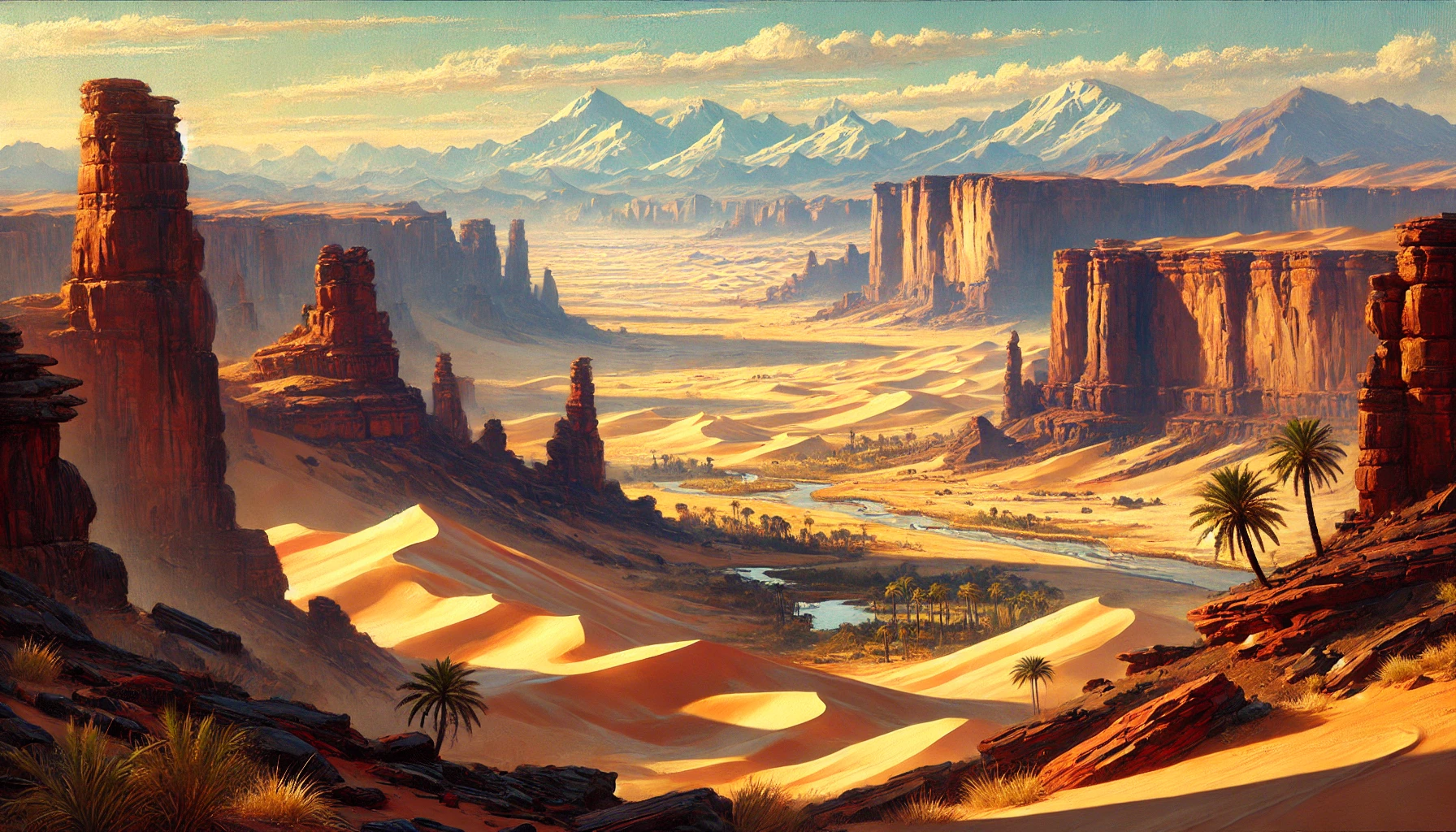
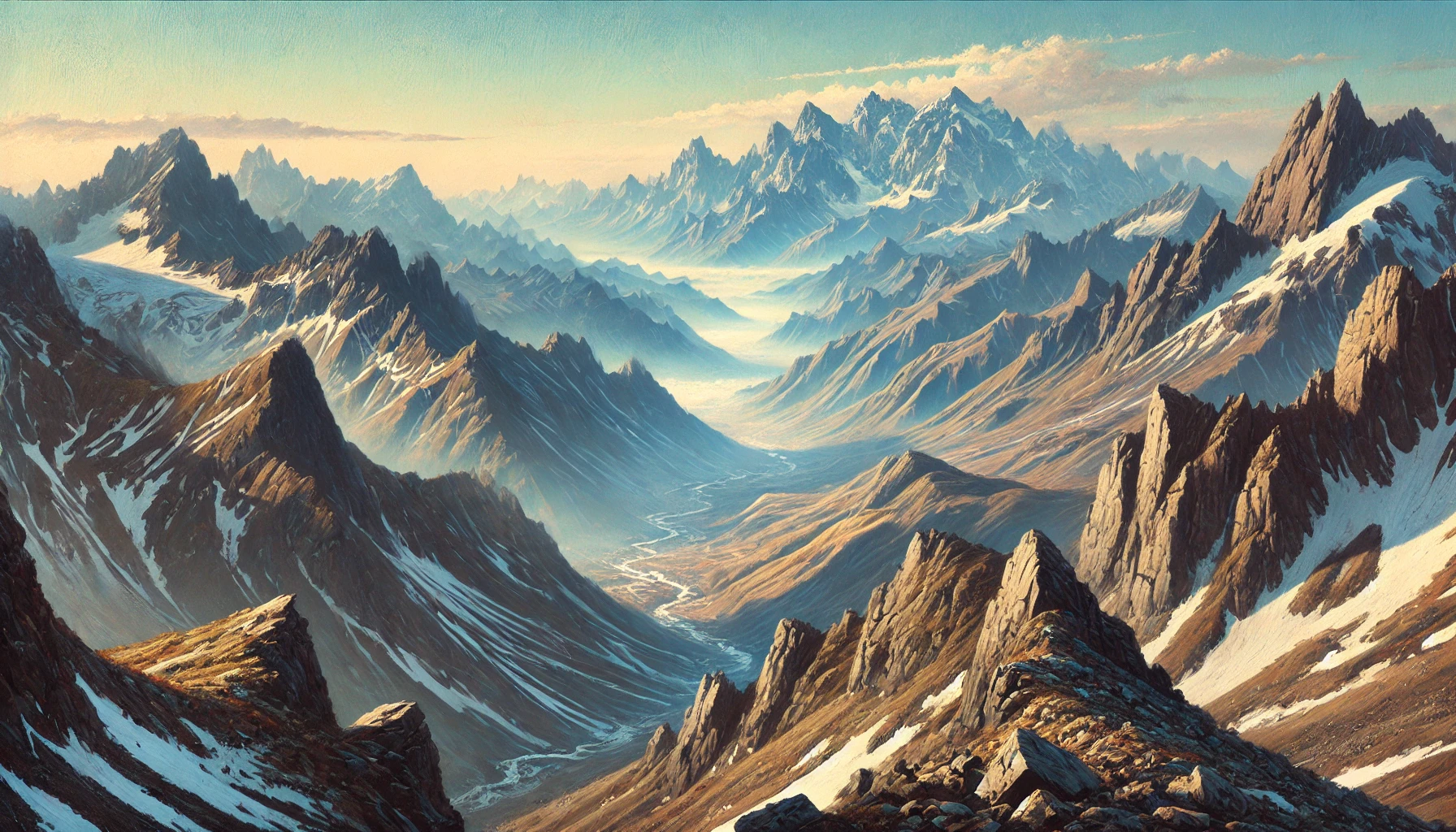
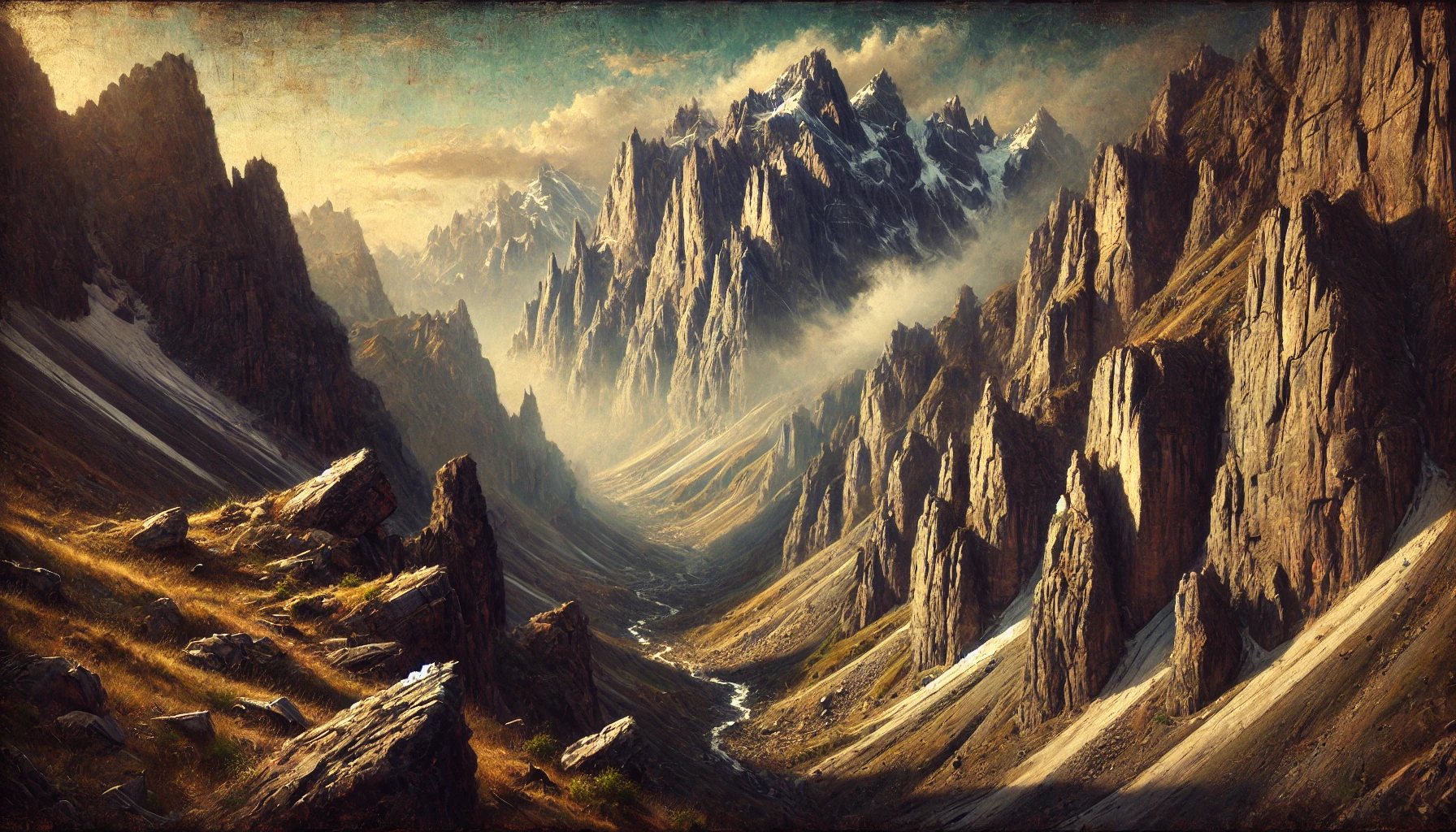
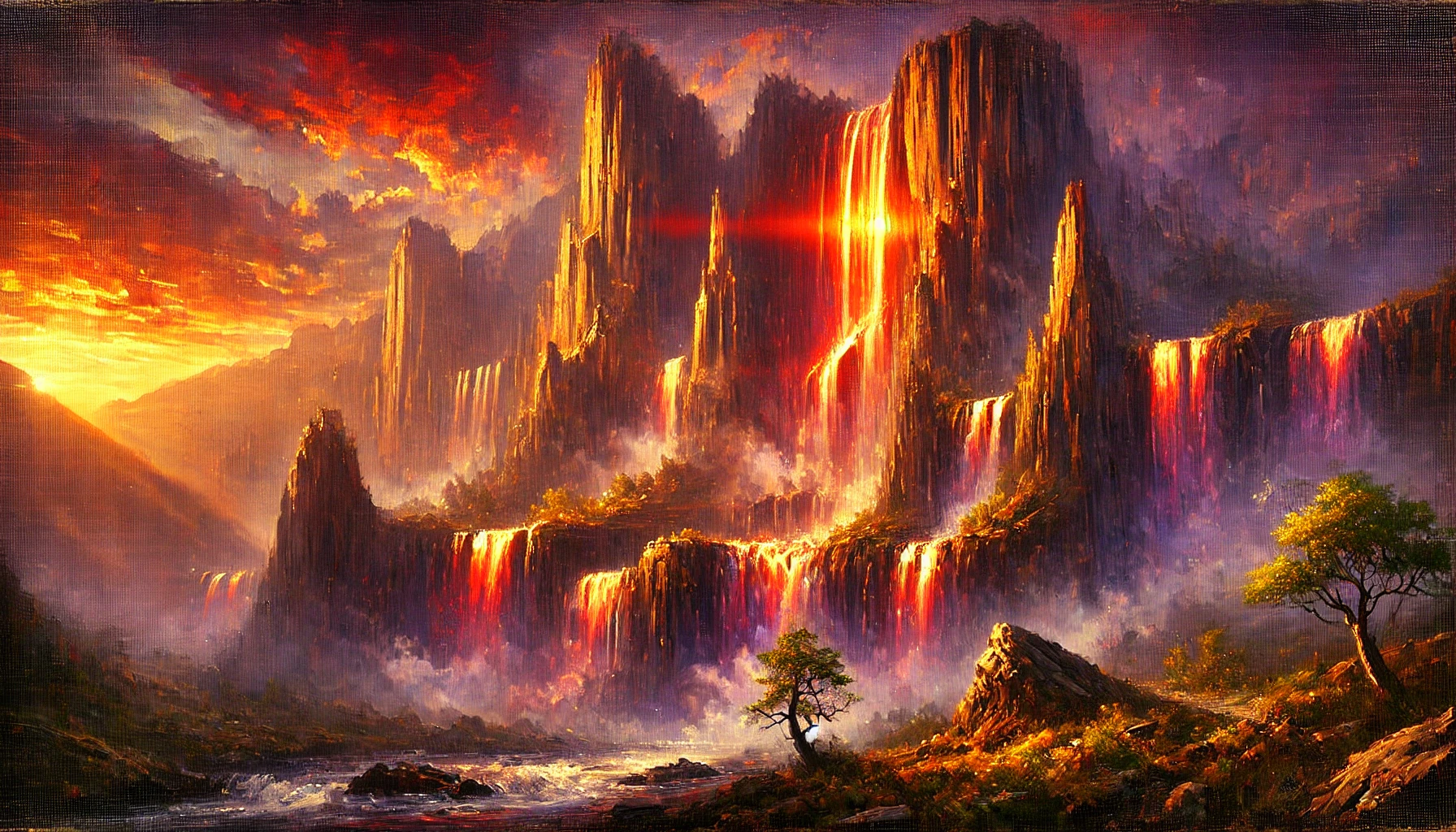

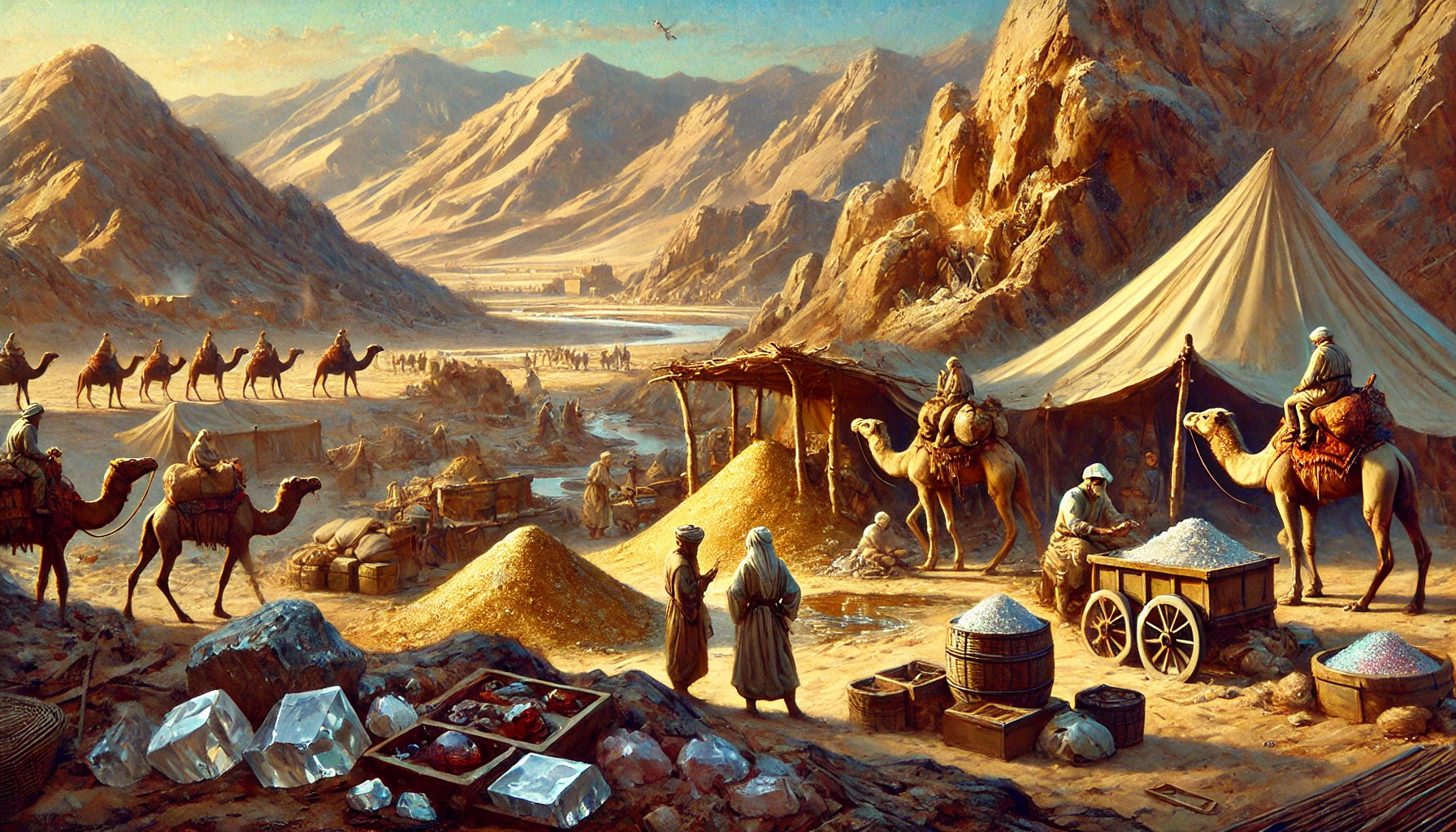
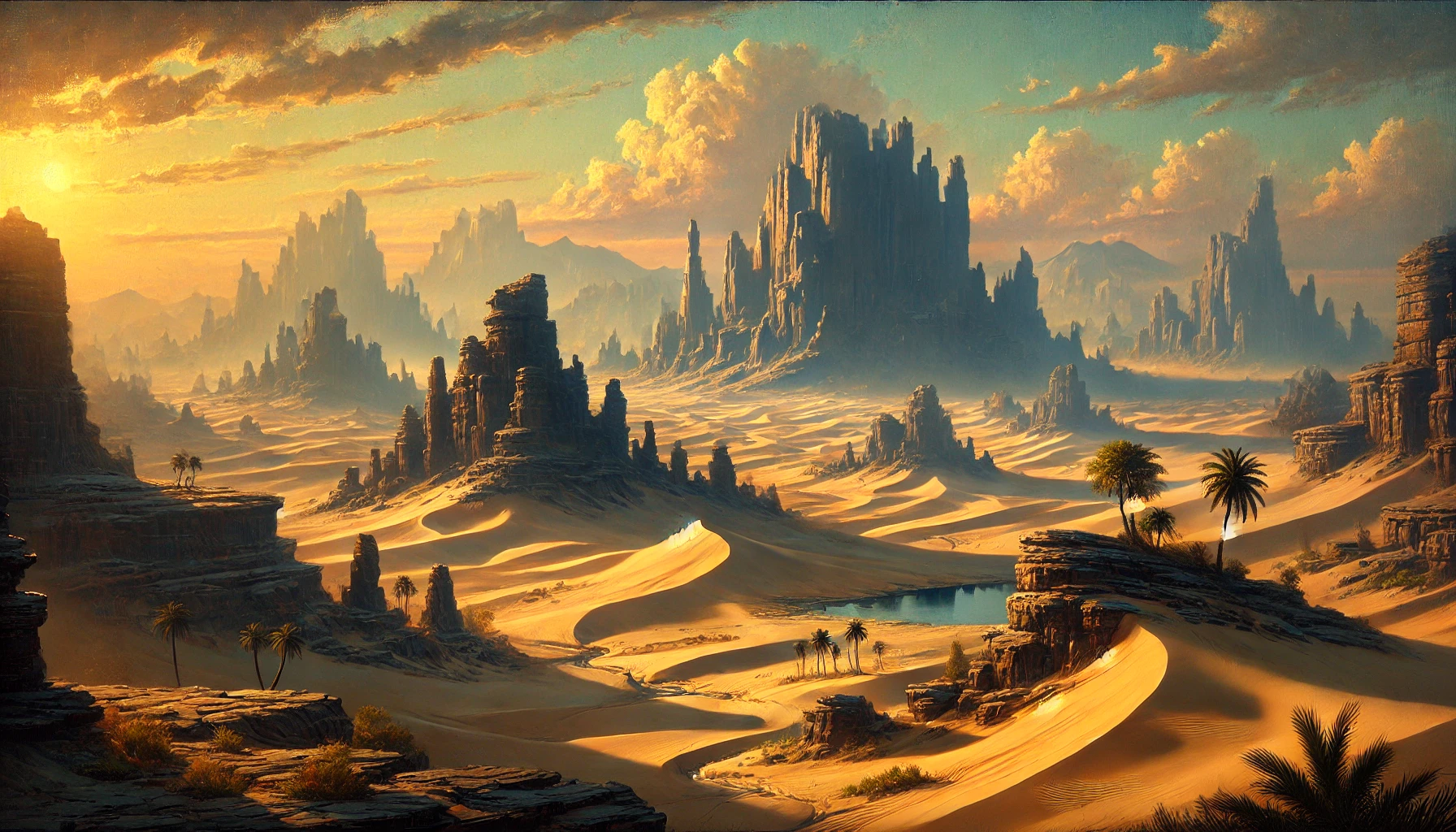



Comments